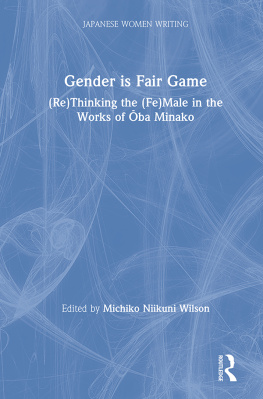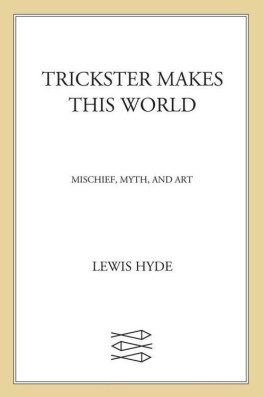
THE MARGINAL
WORLD OF
Michiko Wilsons book is a masterpiece of interpretation. Only she has properly handled e as trickster. Up comes the joker in the pack of literature at last, the true Bakhtinian hero, alive and vocal, dragging around his solely physical son Hikari. e has won the Nobel Prize for literature: let the elitists beware. The postmoderns of the anti-the-body faction, the despair faction, can now smell the earthiness, the urine, and feces, of our blessed human reality, starring the ultimate indignity, a brain-damaged son. Like Faulkner, the story teller rises again, laughter flowering because of the garbage, reversing the tragedy of The Idiot. Michiko Wilsons book flows into the pores and veins of es writing and lets us join her there, reveling in its hot stream. I talk in physical fashion because of the air of enjoyment that pervades her book; yet in it is laid out the liminality of Victor Turner (for e is a classically liminal person), es exuberant symbolism, the insights of Bakhtin, and what is more, all the oddities of present day electronic Japan. Wilsons The Marginal World of e Kenzaburo is indispensable for the understanding of this great writer, who is up there with James Joyce, Faulkner, Gnter Grass, Gabriel Garca Mrquez, Jorge Amadothe Bakhtinian yea-sayers of our era.
Edith Turner, University of Virginia
The Marginal World of e Kenzaburo may be the first extended textual criticism published in English on modern Japanese fiction. It is certainly the first full-length study in English of e Kenzaburo. Wilsons study dazzles the reader with the richness of es creative mind and the luxuriant complexity of its products. This is an important book, as an invitation for those who have not done so to venture into the vibrant, outrageous world of es fiction.
Journal of Japanese Studies
A full-length study, with detailed critical apparatus of biographical notes, endnotes, selected bibliography, and index, dealing with one of contemporary Japans most serious and important novelists. Will be of interest to anyone who wishes to gain an overview of the works of a significant contemporary novelist.
Monumenta Nipponica
Wilson is to be commended for being a careful and thoughtful reader, as well as a literate criticshe has made judicious use of both Western and Japanese critical writing in her study.
Journal of the Association of Teachers of Japanese
e Kenzaburo is arguably the most important novelist writing in Japan today. Michiko Wilsons study of es work, the first of its kind in English, fills an important need and is most welcome.
World Literature Today
THE MARGINAL
WORLD OF
A Study in Themes and Techniques
Michiko Niikuni Wilson
First published 1986 by M.E. Sharpe
Published 2015 by Routledge
2 Park Square, Milton Park, Abingdon, Oxon OX14 4RN
711 Third Avenue, New York, NY 10017, USA
Routledge is an imprint of the Taylor & Francis Group, an informa business
Copyright 1986 Taylor & Francis. All rights reserved.
No part of this book may be reprinted or reproduced or utilised in any form or by any electronic, mechanical, or other means, now known or hereafter invented, including photocopying and recording, or in any information storage or retrieval system, without permission in writing from the publishers.
Notices
No responsibility is assumed by the publisher for any injury and/or damage to persons or property as a matter of products liability, negligence or otherwise, or from any use of operation of any methods, products, instructions or ideas contained in the material herein.
Practitioners and researchers must always rely on their own experience and knowledge in evaluating and using any information, methods, compounds, or experiments described herein. In using such information or methods they should be mindful of their own safety and the safety of others, including parties for whom they have a professional responsibility.
Product or corporate names may be trademarks or registered trademarks, and are used only for identification and explanation without intent to infringe.
Library of Congress Cataloging-in-Publication Data
Wilson, Michiko N.
The marginal world of e Kenzabur
Bibliography: p.
Includes index.
1. e Kenzabur, 1935Criticism and interpretation.
I. e Kenzabur, 1935 . II. Title.
PL858.E14Z981986895.63585-22150
ISBN 0-87332-343-2 (c)
ISBN 1-56324-580-9 (p)
CIP
ISBN 13: 9781563245800 (pbk)
ISBN 13: 9780873323437 (hbk)
Contents
In memory of
Victor Turner
19201983
His peculiar synthesis of innocent eye and sophisticated brain, the late Victor Turner, the world-renowned cultural anthropologist, said of e Kenzaburo, has a prophetic thrust which few novelists today, including Saul Bellow and Gabriel Garca Mrquez, can rival in posing uniquely modern problems and demolishing uniquely modern idols. To place the narratives of this creative mind in the mainstream of world literature is my primary concern in this study. e clearly stands at the juncture of modern Japanese and Western literary traditions. It is refreshing to see how he is totally at ease with a variety of Western intellectual and literary disciplines without sacrificing his Japanese identity.
A treasure-trove for literary critics, es narratives cultivate various foreign and indigenous devices that entice both the reader and the critic to look at literature from an entirely new angle. For me, the formalist/structuralist approach is most exciting and rewarding in dealing with es marginal world. At the same time, I find it essential to analyze his work in terms of the relationship of one narrative to another. My particular focus is to unravel the characteristics of his art and the power of narrative discourse. I hope that this introductory study will stimulate further discussion and translation of his provocative and creative achievements.
Unless designated otherwise, all quotations of es narratives are my translations. When another English translation is available, the first number in a bracket after each quotation indicates the number in the original text; the second, the number in the translation. For Japanese names, I follow the Japanese custom of putting the surname first, given name second. The place of publication for all the Japanese books cited is Tokyo. An earlier version of appeared in The Journal of Japanese Studies 7, 1 (Winter 1981), under the title es Obsessive Metaphor, Mori the Idiot Son: Toward the Imagination of Satire, Regeneration, and Grotesque Realism. For permission to reprint it in a revised and enlarged form I would like to thank the editor.














